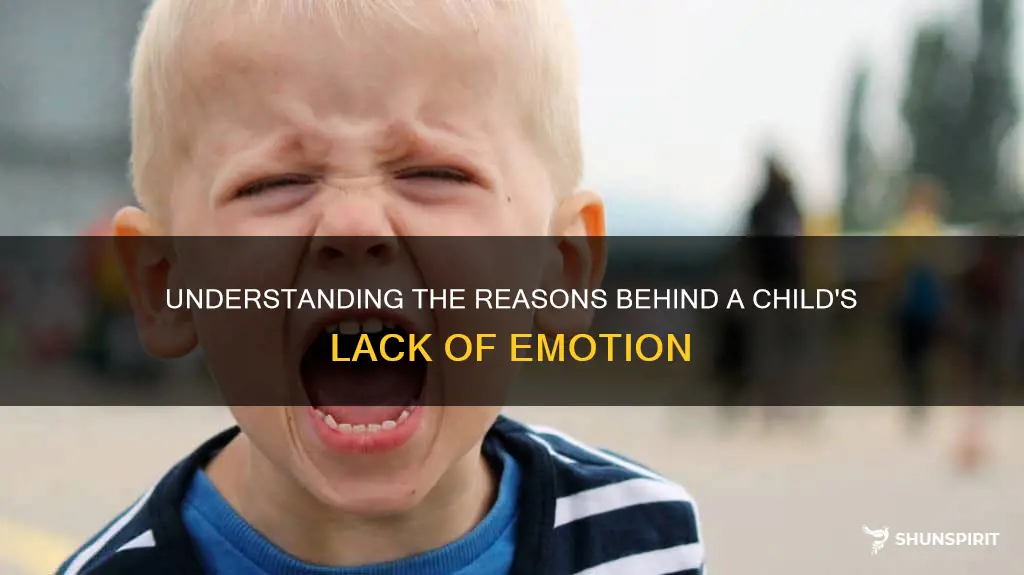
Imagine a world where children express no emotions - no excitement at the sight of a new toy, no fear in response to a thunderstorm, no sadness when a favorite pet passes away. It may seem unimaginable, but for some children, the act of displaying emotions is a foreign concept. This intriguing phenomenon raises many questions about the nature of emotions and the underlying factors that contribute to their development. In this article, we will explore why some children may show no emotion and the potential implications for their social and emotional well-being.
| Characteristics | Values |
|---|---|
| Facial expression | None |
| Body language | Stiff or rigid |
| Eye contact | Avoids or lacks |
| Vocal tone | Monotone or flat |
| Emotion words | Rarely used |
| Empathy | Lacks |
| Social interaction | Withdrawn |
| Playfulness | Absent |
| Emotional responsiveness | Minimal |
| Smiling or laughing | Rare or absent |
What You'll Learn

Introduction: Understanding Emotionless Behavior in Children
Emotions play a crucial role in a child's development and overall well-being. It is through emotions that children express their needs, desires, and concerns. However, there are instances when a child may display a lack of emotion, which can be concerning for parents and caregivers. It is important to understand that emotionless behavior in children is not always indicative of a serious problem, but it does require attention and support.
There can be several reasons why a child may exhibit a lack of emotion. In some cases, it could be a temporary response to a specific situation or event. For example, a child who has experienced a traumatic event or loss may initially shut down emotionally as a defense mechanism. Additionally, certain personality traits or temperament types may contribute to a child's more reserved emotional display.
However, it is also possible that emotionless behavior in a child could be a sign of an underlying issue. Conditions such as autism spectrum disorder, depression, or anxiety can affect a child's ability to express emotions. If you suspect that your child's lack of emotion is persistent, extreme, or impacting their daily functioning, it is important to seek professional help.
To better understand your child's emotionless behavior, here are a few key points to consider:
- Observing patterns: Take note of how often and in what situations your child displays a lack of emotion. Does it happen consistently or only in specific circumstances? Understanding the patterns can provide valuable insights into the underlying factors contributing to your child's emotional behavior.
- Communication and social skills: Pay attention to how your child communicates and interacts with others. Emotionless behavior may be accompanied by difficulties in expressing themselves verbally or non-verbally. Poor social skills or an inability to understand and respond appropriately to emotions displayed by others can also be indicators of an emotional issue.
- Developmental milestones: Consider your child's developmental milestones. Are they meeting typical emotional milestones for their age? For example, by the age of two, most children should start showing a range of emotions, including happiness, sadness, and anger. If your child is consistently not exhibiting these emotions, it may be worth discussing with a healthcare professional.
- Seeking professional help: If you have concerns about your child's emotionless behavior, it is essential to consult with a healthcare professional, such as a pediatrician or child psychologist. They can help assess your child's emotional development, rule out any underlying issues, and provide guidance and support.
- Emotional support and environment: Create a nurturing and supportive environment for your child. Encourage open communication and provide opportunities for emotional expression through play, art, or journaling. Pay attention to your own emotions and model healthy emotional regulation.
Remember, every child is unique, and their emotional development may vary. Keep in mind that some children naturally have a more reserved or introverted temperament, which may result in a less expressive emotional display. However, if you have concerns about your child's overall well-being, it is important to seek professional guidance to ensure they receive the support they need. Understanding your child's emotionless behavior is the first step towards helping them navigate their emotions and thrive emotionally.
Unveiling the Beauty of How Filipinos Express Emotion: A Glimpse into Filipino Emotional Expression
You may want to see also

Possible Causes and Factors Contributing to Emotional Withdrawal
Emotions are an essential part of human experience and serve as a way for individuals to connect with others and understand their own needs and desires. However, some children may display a lack of emotional expression, often referred to as emotional withdrawal. This can be a cause for concern, as it may indicate underlying issues or challenges that the child is facing.
There can be several possible causes and factors contributing to emotional withdrawal in children. It is important to understand these factors in order to provide the necessary support and intervention for the child. Here are some possible causes to consider:
- Traumatic experiences: Children who have experienced trauma, such as physical or emotional abuse, neglect, or witnessing violence, may withdraw emotionally as a coping mechanism. They may feel overwhelmed by their emotions and find it difficult to express or regulate them.
- Attachment issues: Emotional withdrawal can also be a result of insecure attachment patterns. When a child does not have a secure and nurturing bond with a caregiver, they may develop a defensive mechanism of emotional withdrawal as a way to protect themselves from further hurt or rejection.
- Mental health disorders: Some mental health disorders, such as depression, anxiety, or post-traumatic stress disorder (PTSD), can contribute to emotional withdrawal in children. These conditions may affect their ability to experience and express emotions in a healthy way.
- Developmental delays: Certain developmental delays, such as autism spectrum disorder (ASD) or sensory processing disorder (SPD), can affect a child's ability to understand and express emotions. They may have difficulty processing sensory information or understanding social cues, leading to emotional withdrawal.
- Environmental factors: The child's environment can also play a significant role in their emotional expression. If they are living in a high-stress or chaotic environment, they may become emotionally withdrawn as a way to cope with the constant turmoil around them. Additionally, if the child is surrounded by individuals who do not validate or respond to their emotional needs, they may learn to suppress their emotions.
- Genetic and biological factors: It is possible that genetic or biological factors can contribute to emotional withdrawal in children. Research suggests that certain genetic variations and brain chemistry imbalances may influence emotional regulation and expression.
If you notice that a child in your life is displaying emotional withdrawal, it is important to approach the situation with empathy and understanding. Here are some strategies to support the child:
- Create a safe and supportive environment: Provide a calm and nurturing environment where the child feels safe to express their emotions. Encourage open communication and active listening to ensure that they feel heard and understood.
- Foster secure attachments: Work on developing a secure attachment with the child. Offer consistent and reliable care, and build a trusting relationship by responding to their emotional needs in a sensitive and empathetic manner.
- Seek professional help: If you suspect that underlying trauma or mental health issues are contributing to the emotional withdrawal, it is important to seek professional help. A therapist or counselor with experience in working with children can provide the necessary support and guidance.
- Incorporate emotional literacy activities: Engage in activities that promote emotional understanding and expression. This can include reading books about emotions, using emotion cards or charts, or engaging in creative activities such as drawing or role-playing.
- Practice self-care: Lastly, it is vital to take care of yourself as a caregiver. Supporting a child with emotional withdrawal can be challenging and emotional. Make sure to prioritize your own self-care, seek support from loved ones or professionals, and take breaks when needed.
Understanding the possible causes and factors contributing to emotional withdrawal in children is the first step towards providing appropriate support and intervention. By providing a safe and nurturing environment, fostering secure attachments, seeking professional help when needed, and promoting emotional literacy, you can help a child on their journey towards emotional well-being.
The Importance of Emotional and Spiritual Intelligence in Personal Growth
You may want to see also

Impact on Cognitive and Social Development in Emotionless Children
Emotions are a fundamental aspect of human nature, crucial for our cognitive and social development. They help us understand and interpret the world around us, form connections with others, and regulate our behavior. However, when a child shows no emotion, it can have a significant impact on their overall development.
Cognitive Development:
Emotions play a crucial role in cognitive development in children. When a child shows no emotion, it can impact their ability to learn and engage with the world. Emotions provide motivation and drive for exploration, problem-solving, and critical thinking. They help children make sense of their experiences and remember important information.
In the absence of emotions, children may struggle to focus and concentrate on tasks, leading to difficulties in school and other learning environments. Emotions also impact the executive functions of the brain, such as decision-making and impulse control. Without emotions, children may struggle to regulate their behavior and make appropriate choices.
It is essential to recognize that emotions and cognition are deeply intertwined. When a child lacks the ability to express emotions, it can hinder their cognitive development and overall learning potential.
Social Development:
Emotions are the foundation of social interactions. They enable individuals to connect with others, form relationships, and understand the feelings and perspectives of those around them. In the absence of emotions, children may struggle to develop critical social skills.
Children who show no emotion may find it challenging to empathize with others, which can hinder their ability to form meaningful relationships and maintain social connections. They may struggle to understand social cues, non-verbal communication, and the subtleties of social interactions. As a result, they may appear distant, detached, or uninterested in others, making it difficult for them to develop and maintain friendships.
Emotions are also essential for resolving conflicts and dealing with challenging situations. Children who lack emotional expression may have difficulty managing their emotions during conflicts, leading to potential aggression or withdrawal. They may struggle to understand and express their own feelings, making it challenging for others to empathize with them.
Supporting Children who Show No Emotion:
If you are concerned about a child who shows no emotion, it is crucial to seek professional help. A qualified child psychologist or therapist can assess the child's emotional and cognitive development and provide appropriate support and intervention.
Some strategies that may help support emotionless children include:
- Emotional coaching: Teach the child about emotions, how to recognize them, and how to express them appropriately. Provide opportunities for the child to practice expressing emotions in safe and supportive environments.
- Social skills training: Help the child develop social skills, such as empathizing with others, understanding social cues, and effectively communicating their feelings. Role-playing and social stories can be helpful tools for teaching and practicing these skills.
- Psychosocial support: Create a supportive and nurturing environment for the child. Encourage open and honest communication, validate their feelings, and provide opportunities for emotional expression.
- Multisensory activities: Engage the child in activities that stimulate their senses and emotions. Art, music, and movement activities can help the child explore and express their emotions in a non-verbal way.
- Collaborate with professionals: Work closely with professionals, such as psychologists and therapists, to develop a comprehensive plan to support the child's emotional and social development. They can provide valuable guidance, strategies, and interventions.
Remember, every child is unique, and it may take time and patience to help a child develop and express their emotions. With love, understanding, and professional support, you can make a positive impact on the cognitive and social development of emotionless children.
Approaching Someone who Exhibits a Lack of Emotion: Effective Strategies for Communication
You may want to see also

Strategies and Techniques to Help Children Express and Understand Emotions
Emotions play a crucial role in our lives, helping us navigate through various situations and thrive in our relationships. As parents and caregivers, it is our responsibility to teach children how to identify, express, and manage their emotions effectively. However, some children may struggle with expressing emotions, which can often be a cause for concern. In this article, we will explore strategies and techniques that can help children express and understand their emotions, fostering their emotional intelligence and overall well-being.
Create a Safe and Supportive Environment:
First and foremost, it is important to create a safe, non-judgmental, and supportive environment where children feel comfortable expressing their emotions. Encourage open communication and let your child know that it is okay to share their feelings without fear of criticism or punishment. Listen actively and validate their emotions, as this will help them feel heard and understood.
Teach Emotional Vocabulary:
One of the key aspects of expressing and understanding emotions is having a comprehensive emotional vocabulary. Introduce your child to a wide range of emotions and their corresponding words. Start with basic feelings such as happy, sad, angry, and expand to more complex emotions like frustration, jealousy, excitement, and boredom. Regularly discuss emotions in day-to-day conversations, asking your child to identify and label their own or others' emotions.
Model Emotional Expression:
Children often learn by observing their parents and caregivers. Model healthy emotional expression by openly sharing your feelings with them. For example, if you are feeling stressed, say, "I am feeling a little overwhelmed right now because of my workload." This not only allows your child to see how emotions are expressed but also helps them develop empathy and understand that everyone experiences a range of emotions.
Use Visual Aids and Props:
Young children may find it challenging to verbalize their emotions. In such cases, visual aids and props can be extremely helpful. Provide your child with emotion cards or a feelings chart displaying different facial expressions. When your child is experiencing an emotion, encourage them to point to the corresponding emotion card or engage in play activities using stuffed animals or puppets to act out different feelings.
Encourage Artistic Expression:
Art provides a creative outlet for children to express their emotions. Encourage your child to engage in activities such as drawing, painting, or coloring, and ask them to depict how they are feeling. This allows them to visually express their emotions and provides an opportunity for further discussion and reflection.
Foster Mindfulness and Self-awareness:
Teaching children to be mindful and self-aware can greatly enhance their emotional intelligence. Practice activities like deep breathing exercises, meditation, or guided imagery with your child. These techniques help them become more attuned to their emotions, thoughts, and bodily sensations, enabling them to better understand and regulate their emotions.
Problem-solving and Coping Skills:
Emotional expression and understanding are closely linked to problem-solving and coping skills. Teach your child healthy ways to cope with difficult emotions by brainstorming strategies together. Encourage them to think of solutions or engage in activities such as physical exercise, listening to music, writing in a journal, or talking to a trusted adult. Help them recognize that it is normal to have ups and downs, and provide guidance on how to navigate through challenging situations.
Helping children express and understand their emotions is a vital aspect of their overall development. By creating a safe environment, teaching emotional vocabulary, and modeling healthy emotional expression, we can empower children with the necessary tools to navigate their emotional landscape. Utilizing visual aids, encouraging artistic expression, fostering mindfulness, and teaching problem-solving and coping skills further enhance their emotional intelligence. By implementing these strategies and techniques, we can equip children with lifelong skills that will support their emotional well-being and pave the way for healthy relationships in the future.
The Emotional Abuse of Silence: The Impact of Not Communicating After a Conflict
You may want to see also
Frequently asked questions
There could be various reasons why a child may not be showing any emotion. It could be due to a lack of emotional development, trauma, or a personality trait.
It is important to pay attention if your child consistently shows no emotion, as it may indicate an underlying issue. It could be helpful to seek professional advice to understand and address the situation.
Encouraging emotional expression can be done through various means, such as providing a safe and supportive environment, acknowledging and validating their feelings, and teaching them appropriate ways to express emotions.
Yes, a lack of emotion in children can sometimes be a sign of a mental health issue, such as depression or a dissociative disorder. It is important to consult with a mental health professional to assess the situation and provide appropriate support.
Some strategies that may help a child with limited emotional expression include teaching them about emotions and helping them identify and label their own feelings. Additionally, therapy or counseling can be beneficial in addressing any underlying issues contributing to the lack of emotional expression.







